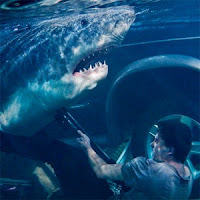Background:
Bait asks the question none of us were asking: what would happen if you were trapped in a supermarket, after a tsunami... with a great white shark? Any self-respecting fan of B-movies already knows the answer to that question though: death, and lots of blood.
Bait 3D caps off a year of 3D films like
Abraham Lincoln: Vampire Hunter, Piranha 3DD and
Frankenweenie that take the idea of 'high-concept' to ludicrous
ly brilliant extremes. Indeed,
Bait went on to become
the highest-grossing Australian film released in China, so this type of 3D cinema is likely to continue.
Native 3D:
Bait was filmed in Australia by many of the people who shot the Second Unit photography in films like the
Matrix trilogy and
Superman Returns. Despite its many and varied challenges under-water, they filmed Bait in Native 3D. Until now, shots like the ones they pulled off have been considered one for the 'too hard' basket. Water photography has always been tough on film crews, but to get the right spacing for stereoscopic cameras has been thought to be nigh-on impossible. According to an interview
here, they shot glorious footage of a submerged supermarket with the help of a uniquely designed air-cooled camera casing, which allowed the crew the flexibility to capture background depth and emotion from their performers too.
Does the 3D 'pop'?
Yes. Almost for comedic effect. The screen is usually a defined wall between the audience and the action, but every now and then a shark will jump several feet out of the water, directly aiming at the audience. There's really not much more to say about this effect - it's a return to the sort of gimmicky 3D shot we traditionally associate with 3D films made before this century. This ought to not be considered a bad thing, mind. Each time the effect was used in the screening 3Defence attended, the (admittedly very small) audience roared with 'so-bad-it's-good' laughter.
How's the depth of the 3D?
In an interview here, the film's director outlines his view on depth in 3D films: "A common misconception is that having objects really close to camera will make things look great in 3D. In fact the opposite is true – it's far more important to make sure there is a mid-ground as well, rather than just a foreground and a background." Certainly, being confined to two or three rooms for much of the film constrains the action to play out reasonably close to the camera, but every now and then the deep background is used to great effect to show off how far away a shark is at any given moment. This depth is actually the cause of most of the tension in the film, because when the depth narrows... we, the audience, know that the shark is nearing its prey.
Did it make sense to film Bait in 3D?
Technically? No. 3Defence never advocates for 3D films set in murky interior locations that lack bright light sources. For business though? Put it this way,
Bait was part financed by Singapore investors, who were determined to get a 3D horror film into Chinese cinemas. Their investment has paid gigantic dividends there.
Bait was made for $8 million, and
has so far grossed over $25 million in China alone. The international market's desire for 3D carnage is something that has yet to be truly capitalised on, but after
Bait's success in China, we suspect many more will try their hand at stereoscopic horror there.
If we had to archive one version, should we save the 3D or the 2D?
Realistically,
Bait is the sort of film you should share with beer and peers. The purpose of the film is to make you laugh, whoop, holler, and have a visceral reaction caused by the odd jump you weren't expecting. All of these things would happen in 2D too. Though the odd throwback to a time where things jumped out at you in 3D is fun, it's not enough on its own to make the 3D version the 'definitive experience' of
Bait. In sum, we're going to side with the 2D version on this one.
The film itself
It's brilliant! The special effects are ropey, the acting is uneven and borderline hammy, but the script hurtles along in a reasonably tight three-act structure that allows most of its characters to have a pay-off moment that makes their role meaningful.
Bait has no right to be this entertaining, but it is, and it's sure to become a must-see cult film.







